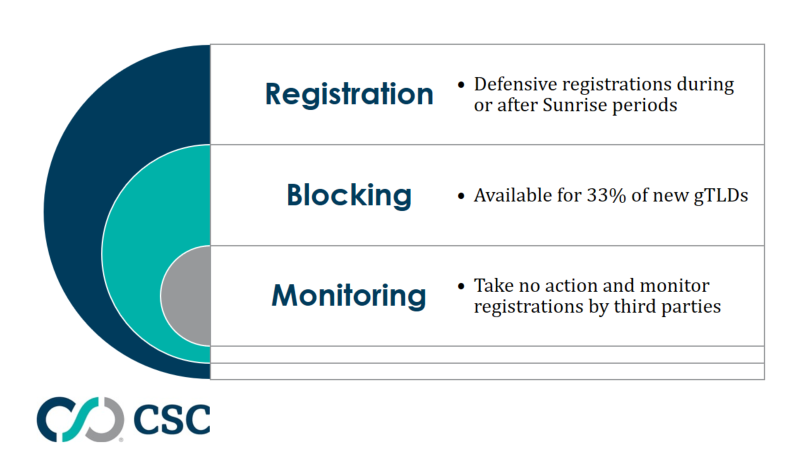Domain registrations, blocking, and monitoring
By Connie Hon, Domain Product and New gTLD manager Share this post



Your domain strategy reflects the security posture of your organization and the value of your brand. The more valuable your brand, the more protective you should be of your brand equity, especially in the digital realm. In this four-part series, we’ll share various defense mechanisms, and how you can use them to protect your online brand.
The brand owner’s toolbox: rights protection mechanisms
When it comes to protecting your brand equity online, there are tools readily available to assist you. These tools were developed by the global internet community and sanctioned by the Internet Corporation of Assigned Names and Numbers (ICANN), the internet governing body. They are known as rights protection mechanisms (RPMs) and they include
- Uniform Domain Name Dispute Resolution Policy (UDRP)
- Uniform Rapid Suspension System (URS)
- Trademark Clearinghouse (TMCH)
- Priority domain registration period, known as Sunrise registration phase
- Domain blocking
In 2012, ICANN’s new generic top-level domain (gTLD) application round received over 1,930 applications. As the number of gTLDs expanded from 22 to close to 1,000 presently, there grew a need for RPMs to protect the rights of trademark holders among these new domain name spaces.
UDRP: the legacy rights protection tool
Before 2013, the most crucial rights protection tool among domain owners was the UDRP. The UDRP allows any entity to file a complaint on the basis of abusive registration, against a registrant of a gTLD name. Once a complaint is filed, a panel is formed and the panel can order cancellation or transfer of a domain name. Similar domain dispute resolution procedures sprung up among some country code top-level domains (ccTLDs), and since there are no such procedures for ccTLDs such as .VN, trademark owners have no legal framework to enforce their legitimate rights on an infringing domain name.
URS: unpopular and underused
At the advent of the gTLD expansion round in 2012, more RPMs were created in anticipation of an increase in the volume of gTLD domain infringement cases. The URS, created in 2013, was designed to be a leaner and nimbler version of the UDRP. The URS required less documentation, cost less, brought a swifter determination, and could only be applied to new gTLDs. The URS, however, required a high burden of proof and provided a limited remedy.
Till date, there are far more domain dispute cases filed through the UDRP than through the URS and one major reason is due to limited remediation through a URS. Unlike the UDRP, where a successful trademark owner can have a disputed domain name canceled or transferred, the URS only allows for the temporary suspension of a disputed domain name until the expiration of the current registration period. Once the suspension period expires, the disputed domain name becomes available for registration again on a first-come, first-served basis, potentially allowing another cybersquatter to scoop it up.
The three-pronged defense mechanism
UDRP and URS are the brand owners’ last line of defense, as having to bear the burden of proof means that some reputational damage has been done. Brand owners are much better off staying ahead of bad acts with defensive domain registrations, domain blocking, and domain monitoring. Together, these constitute a three-pronged defense that must be part of any brand owner’s domain strategy.

Domain registrations: ownership equates to authority
When trademark owners invest in domain dispute proceedings, it’s logical for them to expect to obtain control of the disputed domain names. Ownership is vital since it gives the domain owner an authority over the domain names.
If possible, ownership can and should be in place since the beginning. Corporations know it and that’s why marketers make bulk registrations whenever a new product or service is launched. Likewise, trademark owners should take advantage of priority registrations during Sunrise registration periods, when new gTLDs are launched.
CSC recommends brand owners register core brands and primary corporate marks in new gTLDs that are relevant to their industry vertical. To stay protected outside of these name spaces, brand owners should look to the three-pronged defense of domain registrations, domain blocking, and domain monitoring.
In our second installment of this four-part series, we will discuss how domain blocking fits into your domain name strategy.
>> Contact us for more information on CSC’s domain name management services.